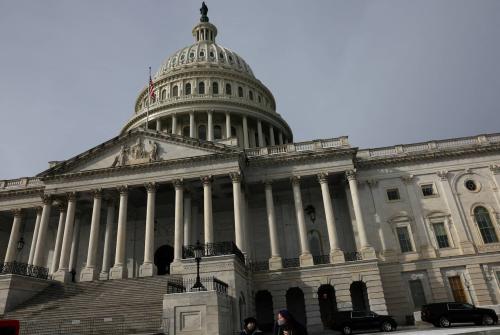With Monday’s counter-proposal from House Speaker Boehner the bargaining has begun. At last it appears the deficit-reduction talks are gearing up.
Why, then, are we underwhelmed?
The problem is that while the negotiation has begun it remains one-dimensional and narrowly focused on the debt. However, America in fact faces a three-part crisis: the current fiscal mess, but also a massive jobs deficit and a disturbing opportunity shortfall, all of which need resolution just as much as our deficit woes.
Forty-one months since the Great Recession, the economy still needs 11.1 million jobs to make up for the jobs lost during the downturn and to keep pace with labor market dynamics.
At same time, the nation faces an opportunity gap with 107 million people either poor or near-poor—the product of an economy that routinely creates jobs that don’t make work pay.
And so the full dimensions of the present juncture can be seen: Even as Congress and the president work to reduce the debt, they must seek to catalyze economic renewal and set a platform for creating more and better private sector jobs.
Put simply: Even as they cut they must paradoxically invest (that is spend) on those things—industrial innovation, infrastructure, education, skills-building—that remain proven sources of long-term growth and prosperity.
How might this work? For sure the needed maneuver will require some radical changes. For decades Washington has spent on things like the mortgage interest deduction that provided a short-term sugar high even as they tilted the economy further from productive growth and more towards a disastrous over-reliance on consumption.
And yet, a way forward appears clear: As Washington moves to scale back it should also “cut to invest,” shifting substantial resources from wasteful, ineffective, or counter-productive spending to transformative, growth-engendering investments.
Don’t believe that the math would work or that the funds are there?
Consider the scenario of implementing a cut-to-invest variant of the much-discussed option of raising revenue by targeting itemized deductions, which primarily benefit the rich. During the election campaign, Mitt Romney proposed paying for big marginal tax rate cuts by placing a cap on total deductions, and the idea has gained some traction since then. According to the Tax Policy Center, a cap of $50,000 (even with exempting charitable contributions) would raise some $490 billion over 10 years.
Yet what if, instead of employing all of that revenue to pay for tax cuts or deficit reduction, half was used for those purposes and half was applied to investments in renewing America? Deployed that way, the cuts in tax expenditures could purchase significant deficit reduction and a lot of investment—say $24 billion a year for each.
What is more, the list of growth- and opportunity-fostering actions that could be paid for in this way is compelling.
- For $6 billion to $8 billion per year the critical R&E tax credit-which fosters industrial R&D and, by extension, growth in good-paying export industries-could be bolstered and made permanent
- For $625 million per year the nation could launch a network of regional advanced industries innovation hubs to accelerate the conversion of basic research into commercially relevant technologies through strong university-industry-government partnerships
- For $95 million per year Congress and the president could reinstate the Build America Bonds (BABs) program which expired in 2010 and which provided important relief to cash-strapped state and local governments seeking to shore up the nation’s crumbling infrastructure
- For less than $4 billion per year they could create a strong new neighborhood reinvestment program employing bonding authority, tax credits, and a special mortgage program to promote real estate market recovery and revitalization of cities and neighborhoods destabilized by recession, job loss, and foreclosures
- And $8 billion per year could fully fund the proposed Community College to Career Fund to forge new partnerships between community colleges and businesses to train 2 million workers for good-paying jobs in high-growth, high-demand industries
Of course, the lists of both potential investments and the inessential or counter-productive tax expenditures or discretionary programs that could be cut to support them could go on and on.
On the cuts side, negotiators on a fiscal resolution really ought to begin to slash away at the $400 billion per year of duplicative, outmoded, or ineffective discretionary programs enumerated by the U.S. Government Accountability Office (GAO) earlier this year. And by all means the dealmakers should phase out such questionable items as subsidies for fossil fuels ($4.86 billion annually) and farm subsidy payments ($5 billion annually).
And at the same time a smart program of investments in clean energy, technology development, high-tech manufacturing, the designation of “manufacturing universities,” and export promotion could play a powerful role in getting the nation moving again. All should be considered.
To be sure, cutting spending, reforming entitlements, and raising revenue in a bipartisan manner are all essential to restoring fiscal discipline and putting our debt back on a downward track. But if we are serious also about restoring the nation’s economic and social well-being, we need to bring investments back onto the ledger. A concerted cut-to-invest drive is how to get started.



Commentary
Op-edCut to Invest to Restore Growth
December 5, 2012